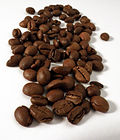

The decline in the ingredient cost of green coffee, while not the only cost component of the final cup being served, occurred at the same time as the rise in popularity specialty cafés, which sold their beverages at unprecedented high prices. According to the Specialty Coffee Association of America, in 2004 16% of adults in the United States drank specialty coffee daily; the number of retail specialty coffee locations, including cafés, kiosks, coffee carts and retail roasters, amounted to 17,400 and total sales were $8.96 billion in 2003.
Specialty coffee, however, is frequently not purchased on commodities exchanges—for example, Starbucks purchases nearly all its coffee through multi-year, private contracts that often pay double the commodity price. It is also important to note that the coffee sold at retail is a different economic product than wholesale coffee traded as a commodity, which becomes an input to the various ultimate end products so that its market is ultimately affected by changes in consumption patterns and prices.

In 2005, however, the coffee prices rose (with the above-mentioned ICO Composite Index monthly averages between 78.79 (September) and 101.44 (March) US Cent per lb). This rise was likely caused by an increase in consumption in Russia and China as well as a harvest which was about 10% to 20% lower than that in the record years before. Many coffee bean farmers can now live off their products, but not all of the extra-surplus trickles down to them, because rising petroleum prices make the transportation, roasting and packaging of the coffee beans more expensive.
Prices have risen from 2005 to 2009 and sharply in the second half of 2010 on fears of a bad harvest in key coffee-producing countries, with the ICO indicator price reaching 231 in March 2011
Classification
A number of classifications are used to label coffee produced under certain environmental or labor standards. For instance, "Bird-Friendly" or "shade-grown coffee" is said to be produced in regions where natural shade (canopy trees) is used to shelter coffee plants during parts of the growing season. Organic coffee is produced under strict certification guidelines, and is grown without the use of artificial pesticides or fertilizers.[citation needed].
Fair trade coffee is produced by small coffee producers who belong to cooperatives; guaranteeing for these cooperatives a minimum price, though with historically low prices, current fair-trade minimums are lower than the market price of only a few years ago. Fairtrade America is the primary organization currently overseeing Fair Trade coffee practices in the United States, while the Fairtrade Foundation does so in the United Kingdom.




Originally, coffee farming was done in the shade of trees, which provided natural habitat for many animals and insects, roughly approximating the biodiversity of a natural forest. These traditional farmers used compost of coffee pulp and excluded chemicals and fertilizers. They also typically cultivated bananas and fruit trees as shade for the coffee trees, which provided additional income and food security.

However, in the 1970s and 1980s, during the Green Revolution, the US Agency for International Development and other groups gave eighty million dollars to plantations in Latin America for advancements to go along with the general shift to technified agriculture. These plantations replaced their shade grown techniques with sun cultivation techniques to increase yields, which in turn destroyed forests and biodiversity.

Sun cultivation involves cutting down trees, and high inputs of chemical fertilizers and pesticides. Environmental problems, such as deforestation, pesticide pollution, habitat destruction, soil and water degradation, are the effects of most modern coffee farms, and the biodiversity on the coffee farm and in the surrounding areas suffer. Of the 50 countries with the highest deforestation rates from 1990 to 1995, 37 were coffee producers

As a result, there has been a return to both traditional and new methods of growing shade-tolerant varieties. Shade-grown coffee can often earn a premium as a more environmentally sustainable alternative to mainstream sun-grown coffee.
| This article relies extensively on quotations that were previously collated by an advocacy or lobbying group. Please improve this article or discuss the issue on the talk page. (December 2010) |

According to the World Fair Trade Organization and the other three major Fair Trade organizations (Fairtrade Labelling Organizations International, Network of European Worldshops and European Fair Trade Association), the definition of fair trade is "a trading partnership, based on dialogue, transparency and respect, that seeks greater equity in international trade". The stated goal is to offer better trading conditions to marginalized producers and workers. Fair trade organizations, along with the backing of consumers, campaign for change in the rules and practice of conventional international trade. However, not all coffee producers are happy with the methods or results.

Fair Trade organizations promote a trade environment in which the coffee importer has a direct relationship with the coffee producer, excluding the middlemen. Coffee importers provide credit to certified farmers to help them stay out of debt with coffee traders so they can develop long-lasting trade relationships. Producer organizations are paid a floor price (Fairtrade Minimum Price) of US$125 cents per pound for Fairtrade certified washed Arabica and US$120 cents for unwashed Arabica, or the market price, if higher. The free trade price of coffee rose above this minimum in September 2007, but due to recent economic events, the free trade price dropped back below this minimum in October 2008. The fair trade price for (conventional natural robusta) coffee has been $1.01 since June 2008 The price of conventional commodity coffee was also over $1 in 2008, but about $0.70 in 2009.

Fairtrade certification is not free; there is an application fee, initial certification fee, membership dues, annual audit fees and more. Certification can cost thousands of Euros for a single plantation. Large corporate farms can often handle the paperwork and recuperate the cost of certification more easily than small, independent farms. As a result, there are plenty of small, independent farms that are not Fairtrade certified even though they meet or exceed the Fairtrade standards.